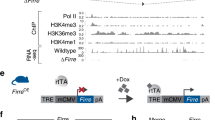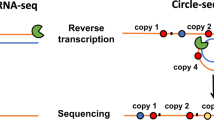Abstract
ELONGATION factor-lα (EF-lα), an essential component of the eukaryotic translational apparatus, is a GTP-binding protein that catalyses the binding of aminoacyl-transfer RNAs to the ribosome1–3. Expression of the EF-lα gene decreases towards the end of the lifespans of mouse and human fibroblasts4,5, but forced expression of EF-lα prolongs the lifespan of Drosophila melanogaster6. Eukaryotic initiation factor-4E, another component of the translational machinery, is mitogenic or oncogenic when constitutively expressed in some mammalian cells7–9. Thus, components of the protein synthesis apparatus seem to be involved in the control of cell proliferation. Using expression cloning, we have isolated a complementary DNA clone from a BALB/c 3T3 mouse fibroblast variant, A31-I-13 (ref. 10), which specifies a factor determining the susceptibility of BALB/c 3T3 to chemically and physically induced transformation. Here we report that the factor is EF-lα and that its constitutive expression causes BALB/c 3T3 A31-I-1 (ref. 10), C3H10T1/2 (ref. 11) and Syrian hamster SHOK12 fibroblasts to become highly susceptible to transforma-tion induced by 3-methylcholanthrene and ultraviolet light. EF-lα messenger RNA is also constitutively expressed in a quiescent culture of the highly susceptible variant A31-1-13. We conclude that the removal of regulation of the expression of these com-ponents of the translational machinery may predispose cells to become more susceptible to malignant transformation.
This is a preview of subscription content, access via your institution
Access options
Subscribe to this journal
Receive 51 print issues and online access
$199.00 per year
only $3.90 per issue
Buy this article
- Purchase on Springer Link
- Instant access to full article PDF
Prices may be subject to local taxes which are calculated during checkout
Similar content being viewed by others
References
Kariro, T. Biochim. biophys. Acta 505, 95–127 (1978).
Hershey, J. W. B. Cell Biology, a Comprehensive Treatise Vol. 4 (eds Goldstein, L. & Prescott, D. N.) 1–68 (Academic, New York, 1980).
Moldave, K. A. Rev. Biochem. 54, 1109–1119 (1985).
Webster, G. C. Molecular Biology of Aging, Gene Stability and Gene Expression (eds Sohal, R. S., Birnbaum, L. S. & Culter, R. G.) 263–289 (Raven, New York, 1985).
Cavallius, J., Rattan, S. I. S. & Clark, B. F. C. Expl Gerontol. 21, 149–157 (1986).
Shepherd, J. C. W., Walldorf, U., Hug, P. & Gehring, W. J. Proc. natn. Acad. Sci. U.S.A. 86, 7520–7521 (1989).
Lazaris-Karatzas, A., Montine, K. S. & Sonenberg, N. Nature 345, 544–547 (1990).
Smith, M. R. et al. New Biol. 2, 648–654 (1990).
Benedetti, A. D. & Rhoads, R. E. Proc. natn. Acad. Sci. U.S.A. 87, 8212–8216 (1990).
Kakunaga, T. & Crow, J. D. Science 209, 505–507 (1980).
Reznikoff, C. A., Brankow, D. W. & Heidelberger, C. Cancer Res. 33, 3231–3238 (1973).
Higashi, T., Sasai, H., Suzuki, F., Miyoshi, J. & Kakunaga, T. Proc. natn. Acad. Sci. U.S.A. 87, 2409–2413 (1990).
Chem, C. & Okayama, H. Molec. cell Biol. 7, 2745–2752 (1987).
Tatsuka, M., Orita, S., Yagi, T. & Kakunaga, T. Expl Cell Res. 178, 154–162 (1988).
Yamasaki, H., Enomoto, T., Shiba, Y., Kanno, Y. & Kakunaga, T. Cancer Res. 45, 637–641 (1985).
Tatauka, M., Owada, M. K. & Mitsui, H. Cancer Res. 52, 4232–4241 (1992).
Kakunaga, T. in IARC Scientific Publication No. 67: Transformation Assay of Established Cell Lines, Mechanisms and Application (eds Kakunaga, T. & Yamasaki, H.) 55–73 (Oxford University Press, New York, 1985).
Breitman, M. L., Tsui, L. C., Buckwald, M. & Siminovitch, L. Molec. cell. Biol. 2, 966–976 (1982).
Lu, X. & Werner, D. Nucleic Acids Res. 17, 442 (1989).
Tatsuka, M., Orita, S. & Kakunaga, T. J. cell. Physiol. 139, 18–23 (1989).
Hirakawa, T., Kakunaga, T., Fujiki, H. & Sugimura, T. Science 216, 527–529 (1982).
Lo, K.-Y. & Kakunaga, T. Cancer Res. 42, 2644–2650 (1982).
Taniguchi, S., Miyamoto, S., Sadano, H. & Kobayashi, H. Nucleic Acids Res. 19, 6949 (1991).
Bockus, B. J. & Stiles, C. D. Expl Cell Res. 153, 186–197 (1984).
Herman, B. & Pledger, W. J. J. Cell Biol. 100, 1031–1040 (1985).
Yang, F., Demma, M., Warren, V., Dharmawardhane, S. & Condeelis, J. Nature 347, 494–496 (1990).
Pardee, A. B. Science 246, 603–608 (1989).
Yagi, T., Sasayama, S., Sasai, H. & Kakunaga, T. Molec. Carcinogenesis 1, 222–228 (1989).
Curran, T., Peters, G., Beveren, C. V., Teich, N. M. & Verma, I. M. J. Virol. 44, 672–678 (1982).
Ausabel, F. M. et al. Current Protocols in Molecular Biology (Wiley, New York, 1987).
Author information
Authors and Affiliations
Rights and permissions
About this article
Cite this article
Tatsuka, M., Mitsui, H., Wada, M. et al. Elongation factor-1α gene determines susceptibility to transformation. Nature 359, 333–336 (1992). https://doi.org/10.1038/359333a0
Received:
Accepted:
Issue Date:
DOI: https://doi.org/10.1038/359333a0
This article is cited by
-
Combined positive effect of oocyte extracts and brilliant cresyl blue stained recipient cytoplasts on epigenetic reprogramming and gene expression in buffalo nuclear transfer embryos
Cytotechnology (2017)
-
Eukaryotic translation elongation factor-1 alpha is associated with a specific subset of mRNAs in Trypanosoma cruzi
BMC Microbiology (2015)
-
Thermal-Stable Proteins of Fruit of Long-Living Sacred Lotus Nelumbo nucifera Gaertn var. China Antique
Tropical Plant Biology (2013)
-
Transcriptome Analysis of Differentially Expressed Genes During Embryo Sac Development in Apomeiotic Non-Parthenogenetic Interspecific Hybrid of Pennisetum glaucum
Molecular Biotechnology (2012)
-
Hepatitis C virus NS4A inhibits cap-dependent and the viral IRES-mediated translation through interacting with eukaryotic elongation factor 1A
Journal of Biomedical Science (2006)
Comments
By submitting a comment you agree to abide by our Terms and Community Guidelines. If you find something abusive or that does not comply with our terms or guidelines please flag it as inappropriate.



